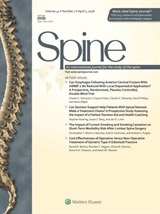 The authors of a study about spinal fusion surgery have retracted it after realizing the cohort study was described as a prospective, randomized trial.
The authors of a study about spinal fusion surgery have retracted it after realizing the cohort study was described as a prospective, randomized trial.
The last author told us he believed the incorrect wording was added to the paper — and the title — by accident. Even though he said the journal Spine suggested correcting it, the authors chose to retract the paper entirely.
The abstract of the study describes the design as a:
Prospective, randomized, controlled trial.
But according to the retraction notice for “Prospective, randomized, controlled trial of silicate-substituted calcium phosphate versus rhBMP-2 in a minimally invasive transforaminal lumbar interbody fusion,” the abstract was not accurate:
The authors of this article have requested a retraction of their article as the article was not a prospective, randomized trial. In fact, this study was a consecutive series of matched cohorts that was retrospectively reviewed. The authors believe the published article does not accurately reflect the methodology employed (ORA#101108 and ORA#11022404). The study was neither prospective, nor randomized but rather a consecutive series of matched cohorts retrospectively reviewed.
The 2014 paper has been cited six times, according to Thomson Reuters Web of Science.
Last author Kern Singh, who works at Rush University Medical Center, told us over the phone that the paper was still scientifically sound:
All the data [are] the same.
He explained that he noticed the error when he was updating his CV. He said he believes the wording was changed by accident:
When it was submitted by my staff, it was changed accidentally.
He added that he suspects that a member of his staff working on the submission of the paper caused the mix-up, and that he wasn’t sure when exactly it happened.
The journal suggested correcting the paper, but Singh told us that he wanted to err on the side of caution in handling the mistake:
The editor suggested that we could just reprint it….We voluntarily pulled it. I suggested it should it go under peer review again…We’re probably being above and beyond conscious…I chose to do that to be the most stringent.
He said he’s now fixed the paper and resubmitted it to Spine.
Since it’s hard to imagine how someone could accidentally change a description of a retrospective cohort study to one that was prospective and randomized — especially in the title — we’ve followed up with Singh to see if he has any further thoughts on how it may have happened.
This isn’t the first problem with the methodology of the study, which earned an erratum less than three months after it was published, for incorrectly stating the the compounds were approved by the U.S. Food and Drug Administration:
The article that appeared on page 185 in the February 1, 2014 issue included a footnote section which incorrectly stated the following:
The device(s)/drug(s) that is/are the subject of this manuscript is/are being evaluated as part of an ongoing FDA-approved investigational protocol (IDE) or corresponding national protocol.
However, the correct statement should be:
The device(s)/drug(s) that is/are the subject of this manuscript is/are not FDA-approved for this indication and is/are not commercially available in the United States. Actifuse was utilized in an on-label fashion whereas rhBMP-2 is considered “off-label” use in the setting of transforaminal lumbar interbody fusion. This was an independent study.
We have reached out to the editor of Spine, and to first author Sreeharsha V. Nandyala — who, according to LinkedIn, is currently a resident at Harvard Medical School — via Facebook. We will update this post with anything else we learn.
Hat tip: Rolf Degen
Like Retraction Watch? Consider making a tax-deductible contribution to support our growth. You can also follow us on Twitter, like us on Facebook, add us to your RSS reader, sign up on our homepage for an email every time there’s a new post, or subscribe to our new daily digest. Click here to review our Comments Policy. For a sneak peek at what we’re working on, click here.